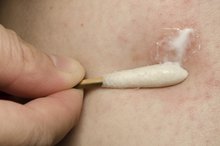Causes of a Red Nose
Red noses have many causes, from inebriation to embarrassment. Diseases that dilate blood vessels cause a reddened nose, along with smoking, excess sun exposure and, in some people, eating spicy foods. Both serious illnesses and minor, temporary conditions cause nose reddening. A red nose is sometimes accompanied by thickening of the skin on the nose, creating a bulbous nose, in chronic conditions.
Alcoholism
Drinking alcohol often causes a temporary reddening of the nose, especially in fair-skinned people. Alcohol dilates the small blood vessels, or the capillaries, allowing more blood to accumulate and making the nose look red. Chronic alcohol leads to permanent dilation of the blood vessels and a chronically red nose, eCureMe.com states.
Systemic Lupus Erythmatosus
Does Drinking Alcohol Cause Nose Pimples?
Learn More
Systemic lupus erythmatosus, often shortened to just lupus or SLE, an autoimmune disease, causes skin manifestations in the form of a butterfly-shaped facial rash in as many as 30 percent of patients, the Lupus Foundation of America reports. The typical butterfly rash of lupus covers the cheeks and crosses the bridge of the nose. The rash of lupus does not affect the sides of the nose or area between the bottom of the nose and top of the lip. The rash may be itchy, and can be either flat or raised.
- Systemic lupus erythmatosus, often shortened to just lupus or SLE, an autoimmune disease, causes skin manifestations in the form of a butterfly-shaped facial rash in as many as 30 percent of patients, the Lupus Foundation of America reports.
- The typical butterfly rash of lupus covers the cheeks and crosses the bridge of the nose.
Rosacea
Rosacea, a skin condition often confused with lupus, causes facial redness that often affects the nose. Small pimples and pustules occur on the face, often in cycles. People between the age of 30 and 60 who have fair skin and a history of flushing or blushing easily most often develop rosacea, MayoClinic.com states. Rarely, enlargement of the oil glands in the nose occurs over a number of years, mostly in men, causing a buildup of tissue called rhinophyma. Topical medications and oral antibiotics may reduce inflammation and redness. A medication used to treat severe acne called Accutane may be used under close physician monitoring, because the drug has potentially severe side effects.
- Rosacea, a skin condition often confused with lupus, causes facial redness that often affects the nose.
- Rarely, enlargement of the oil glands in the nose occurs over a number of years, mostly in men, causing a buildup of tissue called rhinophyma.
Erysipelas
What Are the Causes of a Red Nose?
Learn More
Erysipelas, a bacterial infection most often caused by group A streptococcus, occurs on the face in around 20 percent of cases, according to MedlinePlus. The bacteria enters through small breaks in the skin and causes a painful, raised, hot, swollen red area of skin that can affect the nose. Reddened areas may blister. Fever, chills and malaise often accompany the disease, which is treated with antibiotics.
- Erysipelas, a bacterial infection most often caused by group A streptococcus, occurs on the face in around 20 percent of cases, according to MedlinePlus.
- Fever, chills and malaise often accompany the disease, which is treated with antibiotics.
Related Articles
References
- Mayo Clinic: Rosacea
- MedlinePlus: Erysipelas
- ECureMe: Alcoholism
- Sforza C, Grandi G, De Menezes M, Tartaglia G, Ferrario V. Age- and sex-related changes in the normal human external nose. Forensic Sci Int. 2011;204(1-3):205.e1-205.e9. doi:10.1016/j.forsciint.2010.07.027
- Sharma P, Arora A, Valiathan A. Age changes of jaws and soft tissue profile. ScientificWorldJournal. 2014;2014:301501. doi: 10.1155/2014/301501
- Lee JW, McHugh J, Kim JC, Baker SR, Moyer JS. Age-Related Histologic Changes in Human Nasal Cartilage. JAMA Facial Plast Surg. 2013;15(4):256-262. doi:10.1001/jamafacial.2013.825
- Feng Wen Y, Ming Wong H, McGrath CP. A longitudinal study of facial growth of Southern Chinese in Hong Kong: Comprehensive photogrammetric analyses. PLoS One. 2017; 12(10): e0186598. doi: 10.1371/journal.pone.0186598
- Sforza, Chiarella, Grandi, Gaia, De Menezes, Marcio, Tartaglia, Gianluca M and Ferrario, Virgilio F. Age- and Sex-Related Changes in the Normal Human External Nose. Forensic Science International. Vol 204, Issue 1-3, pp. 205.e1-205.e9
- van der Heijden P, Korsten-Meijer AG, van der Laan BF, Wit HP, Goorhuis-Brouwer SM. Nasal growth and maturation age in adolescents: a systematic review. Arch Otolaryngol Head Neck Surg. 2008 Dec;134(12):1288-93. doi: 10.1001/archoto.2008.501
Writer Bio
A registered nurse with more than 25 years of experience in oncology, labor/delivery, neonatal intensive care, infertility and ophthalmology, Sharon Perkins has also coauthored and edited numerous health books for the Wiley "Dummies" series. Perkins also has extensive experience working in home health with medically fragile pediatric patients.









